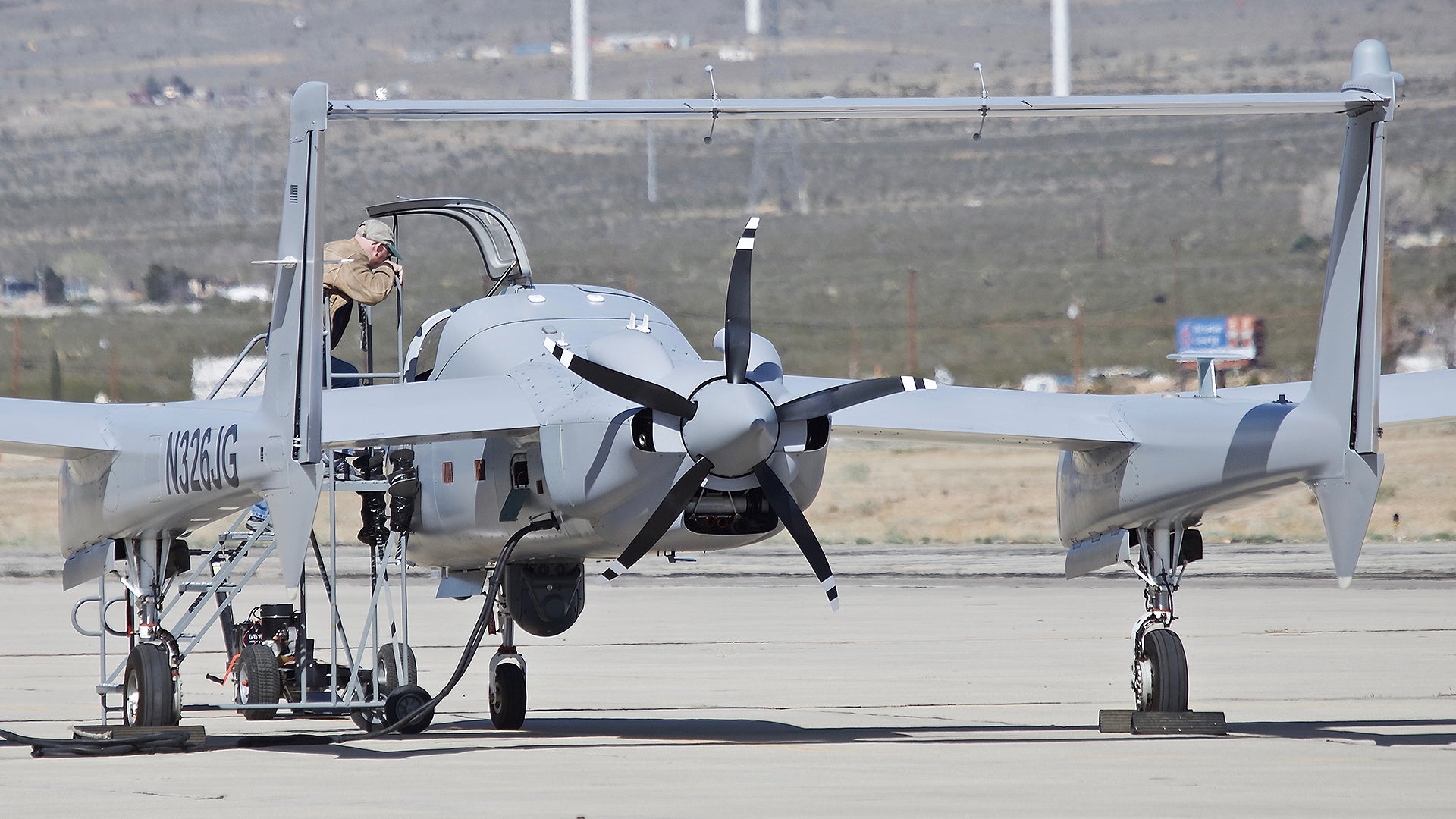We at The War Zone have been keeping a close eye on a small but potentially growing niche market for manned high-altitude intelligence, surveillance, and reconnaissance aircraft, some of which are derived from powered glider-type planes. Now a new entrant into this field, so far known only as the H03, from Northrop Grumman has emerged outside the company’s hangar at the Mojave Air and Space Port in California.
Note to readers: Mystery solved! Feel free to read on but we have a positive ID on this aircraft and good information about its lineage explained in an update at the bottom of this article.
Our good friend and long-time Southern California aerospace photojournalist Matt Hartman, proprietor of Shorealonefilms.com, captured these images of the overall gray aircraft. The Federal Aviation Administration (FAA) only approved the aircraft’s civil registration, N326JG, in August 2017, but we have no way of telling how long Northrop Grumman has been working on the project.
Based on the pictures and the data the FAA makes publicly available, we know that the plane is a pusher type with a single reciprocating engine in the rear of the fuselage and features a tricycle style landing gear.
It has long, slender, glider-like wings and a twin-boom tail arrangement connected by a single large stabilizer. This basic planform is commonly associated with aircraft intended for highly efficient, but typically low-speed flight at high altitudes.
From what looks to be a pair of gull-wing doors on either side of the cockpit, it appears to have a crew of two who sit side-by-side. The overall shape is highly reminiscent of the twin-engine Schweizer 2-38s that the U.S. Coast Guard and Department of Justice flew in the 1990s, but it’s clearly a distinct design.

The pusher propeller, with five narrow-chord blades, is also in line with this concept of operation. This configuration is similar to another experimental, high-efficiency aircraft also being developed in the Mojave Desert by tiny aviation firm Otto Aviation Group, which we were first to report on in 2017.
Otto’s plans for their exotic bullet-shaped aircraft, known as the Celera 500L, includes two turbodiesels along with multi-stage turbochargers, advanced intercoolers, and heat exchangers that drive the aircraft’s main propeller. Though according to the FAA, the existing prototype only has one engine, it is possible that the company listed the arrangement as a single unified powerplant.
This particular design is patented, but Northrop Grumman may have employed a similar concept on the H03. This would make a lot of sense in combination with the overall airframe design and its likely mission set and could explain the number of large air inlets that protrude out around the engine compartment.
This not saying that such an arrangement is being used on the H03 definitively, another simpler powerplant could be used instead. Yet integrating some powerplant advancements into the high-flying design would help support the case for developing such an aircraft in the first place.
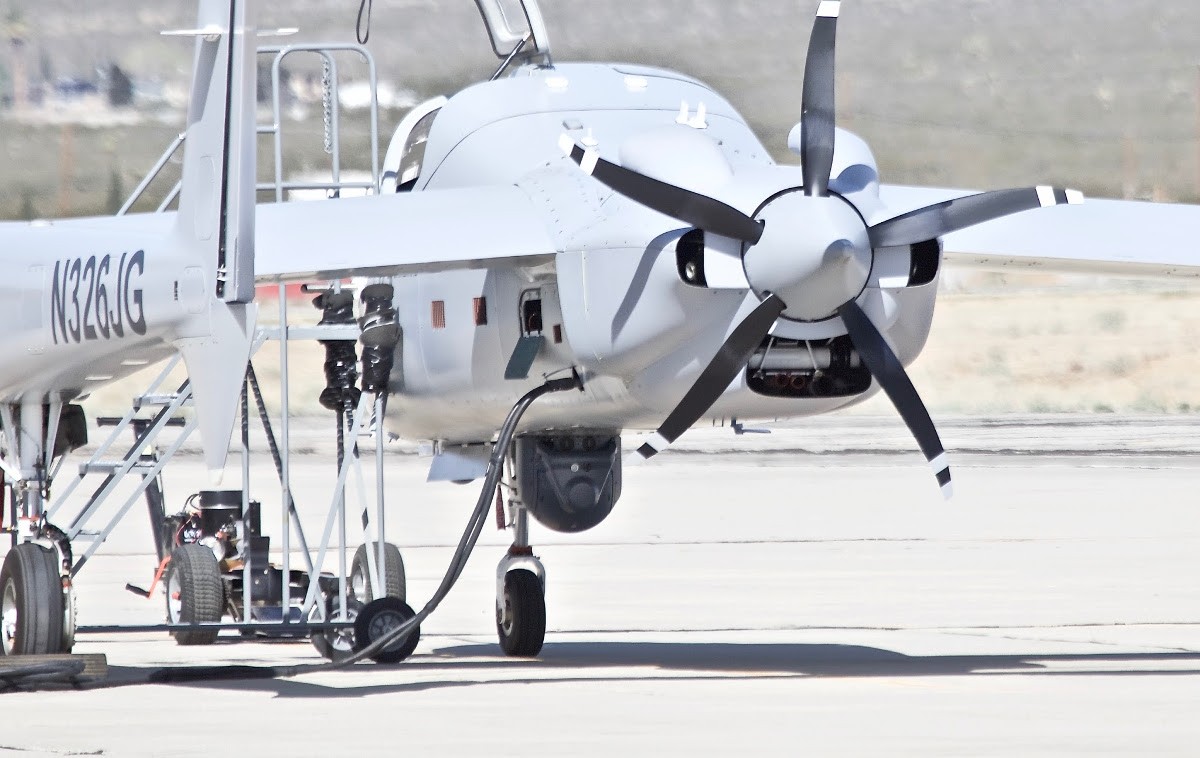
We don’t know what Northrop Grumman made the aircraft’s wing and body out of, but lightweight composites are highly likely as they could give the aircraft even more impressive performance characteristics. This would have been an easy lift for Scaled Composites, the famed boutique aircraft design and manufacturing firm that Northrop Grumman acquired in 2007.
Those materials could potentially help reduce the plane’s radar signature, as well. The overall design, especially the engine configuration and propeller shape, could also give it reduced acoustic and infrared emissions.
All of this would make sense given the H03’s apparent intelligence, surveillance, and reconnaissance role. The aircraft has a large sensor turret mounted underneath the fuselage, which could hold electro-optical, infrared, or multi-spectral video cameras, as well as laser range-finders or designators.
There is a “platter” antenna on the right boom typically associated with UHF satellite communications, as well. There are likely other line-of-sight data-links which would allow the crew to transmit imagery back to base or to personnel on the ground in near real time. An antenna on the right tail could also provide connectivity or it could be used as part of an electronic intelligence gathering installation.
There are no other mission systems readily visible, but the aircraft could have modular equipment bays for additional sensors. With the H03’s single engine, the nose is likely made available to carry various modular sensor payloads, as well. The 2-38, from which this design appears to be based on, at least conceptually, had a push-pull propeller arrangement that took up the bulk of the space forward of the cockpit.
Additional equipment could include signals intelligence suites to monitor a target’s communications or compact synthetic aperture radars that can capture images through clouds, smoke, and other obscurants. A radar could also have a ground moving target indicator capability giving the aircraft more ability to monitor targets or more rapidly identify potential objects of interest.
Northrop Grumman already supplies the AN/ZPY-5 Vehicle and Dismount Exploitation Radar, or VADER, to the U.S. Army and other government agencies for use on small manned surveillance aircraft and drones. The company is developing an improved Long Range Radar (LRR) with similar functionality, as well. These systems are sensitive enough to track human movements under various circumstances.

These sensors, combined with the plane’s likely performance characteristics, could form a manned platform capable of persistent intelligence, surveillance, and reconnaissance missions over a particular area for a protracted period of time. Its potential low signature features might allow the crew to perform those tasks discreetly and with a low probability of detection, especially against targets in low-threat environments such as insurgents, terrorists, and smugglers.
The aircraft’s basic features coupled with a wide-angle or multi-camera wide-area aerial surveillance system would make it an ideal platform for developing so-called “patterns of life” for a particular individual or small group. This process involves intelligence analysts using imagery, radar data, and other forms of information to the better understand a target’s daily routines and typical movements, which in turn can help identify other subjects of interest or discreet bases of operations, especially within urban areas.
And though we don’t know if Northrop Grumman has made this aircraft for a particular customer or as a private venture, it is obvious that there is a continued market for such planes. As already noted, the Coast Guard and Department of Justice have both operated similar designs in the past.
Those Schweizer 2-38s configured for surveillance missions were themselves the outgrowth of concepts dating back to the Vietnam War. The H03’s propeller shape is actually very similar to the one on Lockheed Martin’s Vietnam-era YO-3A “quiet airplane.”
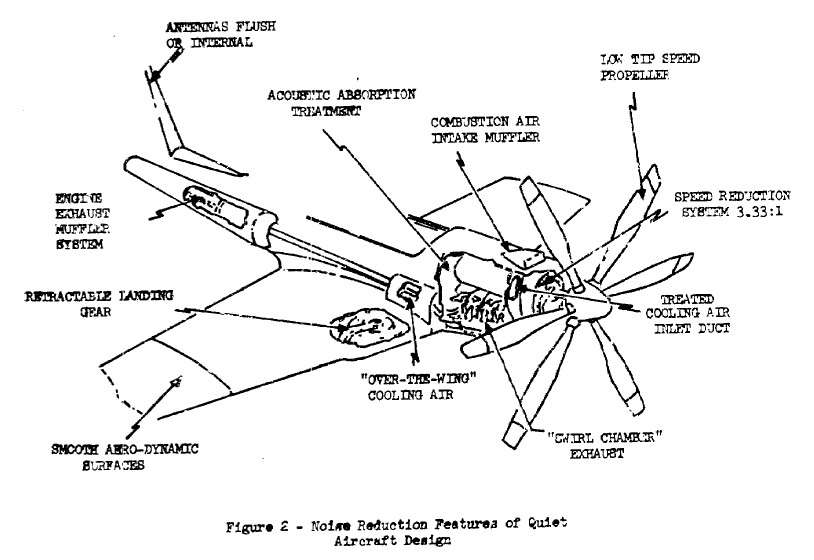
The Coast Guard had been eyeing successors to its 2-38s, which were designated RU-38As, under the Manned Covert Surveillance Aircraft (MCSA) program. The U.S. Air Force’s 645th Aeronautical Systems Group, a special projects office better known as “Big Safari,” managed the project on the service’s behalf.
In 2014, the Coast Guard asked the Air Force to terminate the contract with Sikorsky, which had purchased Schweizer in 2004 and was working on two MSCA prototypes, over delays and cost issues. That project formally ended entirely in 2016, according to a response The War Zone obtained via the Freedom of Information Act.
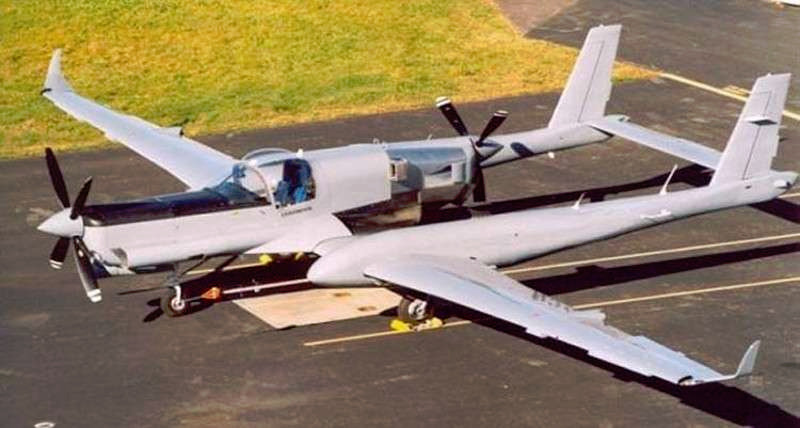
But interest elsewhere within the U.S. government for such a platform appears to persist. In July 2017, a Grob G 520, yet another similar type of aircraft, stopped at the North Vernon Municipal Airport in Indiana ahead of a series of U.S. military special operations forces exercises. The German manufacturer claims its latest G 520NG variants has the “lowest operational cost in class.”
So, the H03 could just offer a similarly cost-effective surrogate for other more advanced manned and unmanned high-altitude intelligence, surveillance, and reconnaissance aircraft, such as the U-2 Dragon Lady, RQ-4 Global Hawk, or even the RQ-170 Sentinel or a still classified aircraft.
With this in mind, the H03 could be charted by various military and law enforcement organizations to stand-in for those more advanced types. Additionally, having a pilot at the controls means the aircraft can venture where unmanned systems currently cannot, and is far more deployable when it comes to supporting exercises and training evolutions.
Similar types of manned aircraft that can stand-in for advanced high-altitude, medium and long-endurance surveillance aircraft are already in high demand for these tasks. They also work as testbeds to see how sensors and other systems function at high altitudes and under certain scenarios. Often times both tasks go hand-in-hand, where new payloads and sub-systems are rapidly evaluated during complex training exercises.

For the same reasons the H03 would make a great surrogate for training and testing purposes, it also offers potential customers a less complex alternative to purchasing a drone with similar capabilities. It also may get around possible export concerns related to providing advanced unmanned high-altitude surveillance aircraft to foreign countries.
Whatever the role Northrop Grumman intends for the H03’s exactly and whether the company has any customers in line yet, it is a clear indication that there is still a market for this class of aircraft. We’ll definitely be watching for more developments on this particular project and for any future appearances the plane might make in public.
Update:
The aircraft in question happens to be an evolved iteration of Scaled Composites Firebird optionally manned long-endurance aircraft. In fact, it appears to be a new variant of that second iteration.
The original Firebird had a similar configuration but was a far more experimental looking affair and was about 30% smaller than the second iteration. Apparently, the second seat was added to the updated design at the behest of a still unknown buyer so that a copilot/payload operator could accompany the pilot when on manned missions.
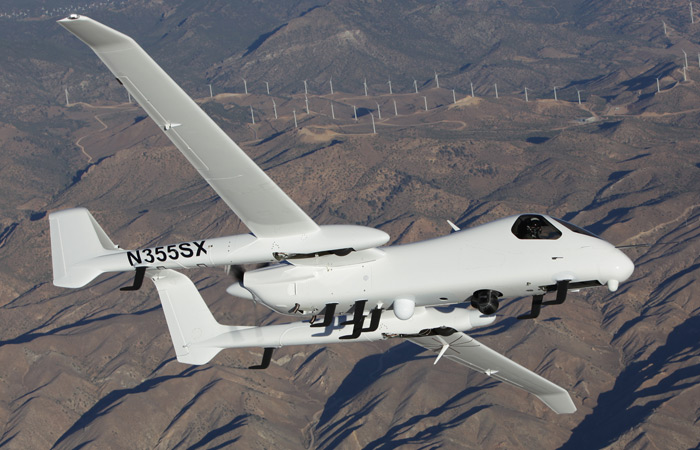
The aircraft can fly without a crew onboard. When unmanned, a ground control station commands the aircraft via line-of-sight (LOS) data-links or a beyond-line-of-sight (BLOS) satellite communications package that fits inside the cockpit. For the BLOS mode, the cockpit instruments come out and the canopy is replaced by a radome fairing that guards the satellite communications dish against the elements.
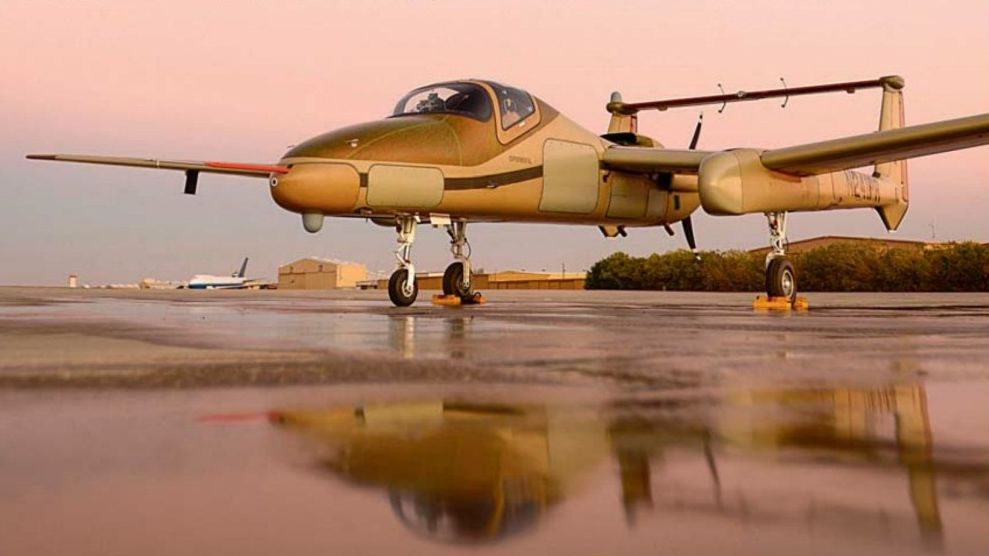
Apparently, after around 2013 two of these aircraft were to be built a year for an unspecified customer, but that seems unlikely to have occurred considering how little we have seen of them. But a couple variations do exist, at least based on FAA registrations and our observations.
The one pictured in the first part of our article seems to have some alterations when compared to the earliest examples of the second generation Firebird. Most notably longer wings seem to have been fitted and changes have been made to the engine and nacelle configuration.
This is likely why the designation is H03 instead of R02, which was assigned to at least two earlier iterations of the second generation Firebird. The FAA’s database says Northrop Grumman has two R02s (N241PR and N412DB) and one H03 (N326JG) registered to it. N355SX is the tail number of the original Firebird demonstrator aircraft.
Supposedly a new Firebird costs just $10M in 2012 dollars and that includes a basic sensor and communications setup. Scaled Composites saw the aircraft just as we thought—as a platform for efficiently executing special long-endurance surveillance missions around the globe. And one that could be ferried to new locations by pilots before executing missions in theater in a manned or unmanned state.
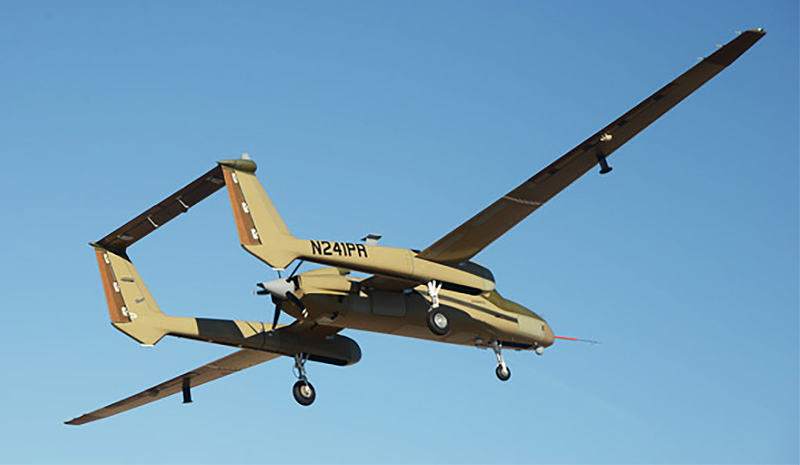
The original Firebird could supposedly loiter for 40 hours at a time, which would make it more capable than the most advanced MQ-9 Reaper available and would even challenge the Global Hawk’s endurance capabilities. It’s not clear if the updated model is capable of such extreme performance with any sort of load, as its endurance is stated as being between 24 and 40 hours, but with the new upgrades maybe this is possible.
Firebird aircraft have flown with all types of payloads, often being rapidly reconfigured to meet different demands in the field. These payloads include radar, electro-optical, communications relay, and signals intelligence suites. The aircraft can supposedly carry nearly 1,250lbs of sensors in its cavernous fuselage bays and in its sponsons.
As for the aircraft’s powerplant, supposedly it uses a fairly pedestrian turbocharged Lycoming TEO-540E engine, which is a testament to the airframe’s super-efficient design. But it appears that the cowling configuration was changed on the H03 so it’s not clear if this engine is still being used. It’s possible that a new engine and wing combo was designed to boost the aircraft’s altitude, endurance, and load carrying capacity. In its original configuration, it could supposedly fly in the 30,000-35,000 foot altitude range as fast as 200 knots.
All in all, the Mojave mystery planed turned out to me even more interesting and dynamic than we originally thought. Now with the basic part of this riddle solved we will be looking into who actually may have bought one of these aircraft, and if so, where has it been operating and what missions has it been accomplishing since it changed hands.
Contact the author: jtrevithickpr@gmail.com
